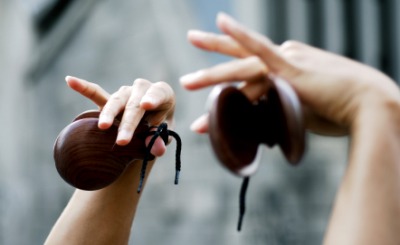Flamenco is a kind of Spanish folk music and dance which come from Andalusia. It grew up from Andalusian, Romani and Hindu music (motion of fingers, feets and hands). Some people say that flamenco comes from hindu dance katak.
Nowadays many flamenco's dancers are Romani people.
Typical women costume is a long, red or black dress with furbelows and high heel shoes. Men wear black or brown trousers, white shirt, heavy heels and hat.
Very important role plays Spanish guitar, castanets and rhythm which is achieved by rhythmic stamping of the feet and emotional intensity and expressive use of arms.
 Castanets
CastanetsThere are differents kinds of flamenco:
- Flamenco puro: dancer dances solo, it has influence gitano music and style
- Classical flamenco: the most popular flamenco in Spain, not to many hips movements, long arms and the body is tightly held
- Flamenco nuevo: the newest style of flamenco, pared-down costumes, it has a lot of influence from other styles of music and dance
In present time flamenco is very popular all over the world. In many countries are established school where people learn flamenco. There are more flamenco schools in Japan than in Spain.
 Spain
Spain

 Tapas
Tapas